Overview
Team leadership characteristics represent a critical array of skills and attributes that empower leaders to adeptly steer their teams toward common objectives while cultivating a culture of trust and accountability.
Why is this significant? Emotional intelligence, adaptability, and communication stand out as pivotal elements. Leaders must actively engage their teams through precise goal-setting and the acknowledgment of achievements. This approach not only enhances overall performance but also elevates employee satisfaction, reinforcing the notion that effective leadership is foundational to organizational success.
Key Highlights:
- Team leadership involves guiding individuals or groups toward shared objectives through a combination of skills and attributes.
- Effective leaders balance task management with team motivation, fostering trust and accountability for high performance.
- A significant gap exists in the perception of purpose between C-suite executives (63%) and entry-level employees (41%), indicating a need for better leadership engagement.
- Management development is crucial for improving staff engagement and retention, yet only 5% of companies fully integrate it into their strategies.
- Emotional intelligence, adaptability, and communication are increasingly vital leadership characteristics as organizations face dynamic challenges.
- Effective communication is essential for team cohesion, with 30% of staff feeling supervisors lack group-building skills.
- Leaders must establish clear goals, assign tasks efficiently, and support team members to enhance performance.
- Diversity in leadership roles contributes to better organizational outcomes, with 40% of HR Director positions held by women.
- Ethical leadership fosters a positive culture and enhances organizational reputation, with 85% of workers indicating that management pressure can lead to unethical behavior.
- Different leadership styles, such as transformational and transactional, significantly impact team dynamics and performance.
- Strategies for high-performing teams include open communication, recognition of achievements, and team-building activities to enhance collaboration.
Introduction
In a rapidly evolving workplace, the role of team leaders has never been more critical. As organizations strive for success amidst increasing complexity and diversity, effective leadership emerges as a cornerstone for fostering collaboration and driving performance. Leaders today are not merely task managers; they are visionaries who inspire, engage, and cultivate a culture of trust among their teams.
This article delves into the multifaceted nature of team leadership, exploring essential qualities, the significance of communication, and the challenges leaders face in guiding diverse teams toward shared objectives. By examining various leadership styles and strategies, it highlights the profound impact that effective leadership has on organizational success and employee satisfaction.
As the landscape of work continues to change, understanding and embracing these dynamics is vital for any leader aspiring to create high-performing teams.
Understanding Team Leadership: An Overview
Group direction embodies the capacity of individuals or collectives to guide and influence a unit toward achieving shared objectives. This multifaceted role integrates a spectrum of skills, behaviors, and attributes indicative of team leadership characteristics, empowering leaders to inspire group members, cultivate collaboration, and optimize overall performance. In the current fast-paced and dynamic work environments, the team leadership characteristics that foster effective collaboration and adaptability are increasingly vital for organizations aiming to thrive.
Leaders bear the dual responsibility of managing tasks while simultaneously inspiring and engaging their teams. This dual role is crucial for nurturing team leadership characteristics that foster a culture of trust and accountability—foundational elements for high-performing teams. Recent data reveals that 63% of C-suite executives find meaning and purpose in their roles, underscoring the importance of guidance in shaping organizational culture and enhancing staff satisfaction.
In stark contrast, only 41% of individuals in entry-level positions report similar feelings, highlighting a potential disconnect that adept leaders can bridge.
Real-world examples illustrate the significant impact of team guidance on performance. Organizations prioritizing management development frequently witness substantial improvements in staff engagement and retention. Monitoring individuals’ career trajectories following management training serves as a testament to the program’s effectiveness, reinforcing the necessity of investing in leadership development.
A case study on management burnout indicates that 65% of leaders experience symptoms of burnout, which can severely impede productivity and elevate turnover rates. Addressing this concern is imperative, as organizations grappling with high levels of burnout among their leaders encounter challenges in sustaining employee engagement and overall performance.
As Ryan Bradshaw, a leading engineering recruiter, articulates, “As top engineering recruiters, we help candidates find great jobs and employers recruit engineering, design, and IT talent.” This perspective underscores the critical role of recruiters in connecting candidates with opportunities that can shape their careers and influence organizational success.
Looking ahead to 2025, prevailing trends in team leadership characteristics highlight the necessity for emotional intelligence, adaptability, and robust communication skills. Leaders are increasingly expected to be empathetic and responsive to their teams’ needs, fostering an inclusive environment that embraces diverse perspectives. Moreover, the capacity to navigate change and uncertainty is becoming a hallmark of effective guidance as organizations continue to adapt to market demands.
In conclusion, the attributes of successful group facilitators are evolving, particularly the team leadership characteristics that emphasize relational skills and the ability to inspire. The impact of strong group leadership on organizational success is profound, as it directly affects team dynamics, employee satisfaction, and overall business outcomes.
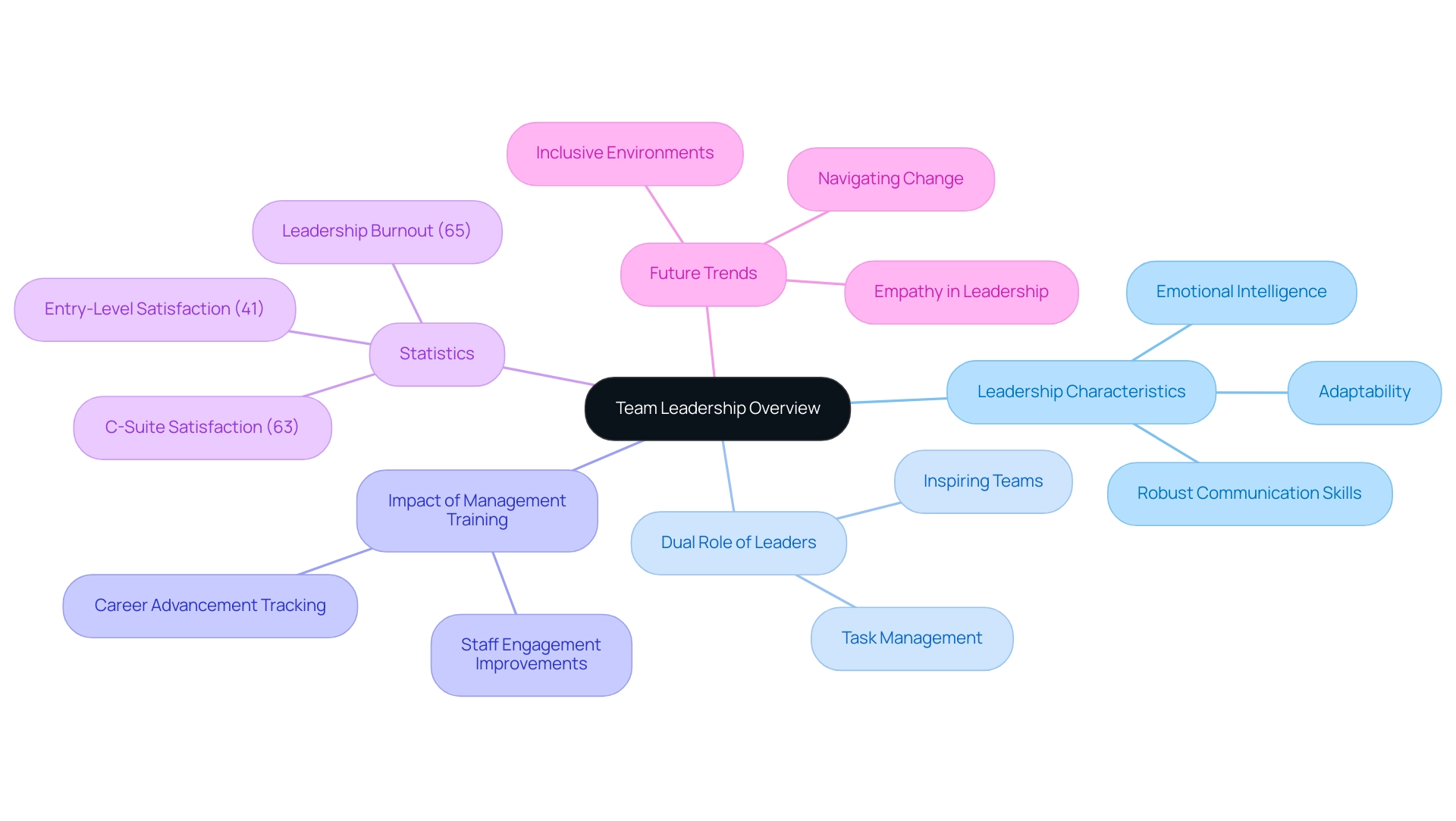
Key Qualities of Effective Team Leaders
Successful group facilitators embody a range of essential traits that exemplify team leadership characteristics and drive group achievement. Effective communication abilities stand out as vital for demonstrating these leadership qualities; those in charge must articulate a clear vision and inspire group members while fostering an inclusive environment. Emotional intelligence is equally critical, as individuals who exhibit empathy can better understand their group’s challenges, leading to improved morale and productivity.
Consider this: when leaders connect with their employees to reinforce group and company purpose, celebrate accomplishments, and cultivate peer relationships, employee engagement can soar—by as much as 747%. Adaptability emerges as a key characteristic of successful leaders, empowering them to navigate the complexities of a rapidly changing work environment. Decisiveness further enhances team leadership, allowing individuals to make informed choices swiftly, which is essential for maintaining momentum within the group.
Integrity and accountability are foundational leadership traits, fostering trust and respect among team members and motivating individuals to take ownership of their roles and responsibilities.
Statistics reveal that 48% of leaders prefer developmental assignments, highlighting a commitment to continuous improvement and growth in their positions. This preference underscores the importance of integrating management development into organizational strategies. Yet, despite the recognized significance of development in management roles, only 5% of companies have fully embraced it within their strategic initiatives, revealing a substantial gap between the perceived value of these skills and their actual prioritization.
This disconnect suggests organizations may be overlooking the benefits of effective guidance, as evidenced by Boutique Recruiting’s impressive track record of success and numerous satisfied clients and candidates.
As organizations increasingly seek innovative solutions, AI-powered coaching tools are projected to save companies an estimated $20 billion by 2027, emphasizing the growing recognition of effective guidance’s impact on organizational success. By prioritizing emotional intelligence and nurturing essential managerial qualities, businesses can enhance their team leadership characteristics, ultimately improving group dynamics and boosting overall performance.
The Role of Communication in Team Leadership
Communication is fundamental to effective team leadership characteristics, serving as the backbone for the exchange of ideas, feedback, and essential information. Leaders who exhibit these characteristics prioritize open communication, creating an environment where group members feel heard, valued, and empowered. This can be accomplished through regular check-ins, transparent decision-making processes, and actively encouraging feedback from all group members.
Data from the 2019 People Management Report by Predictive Index shows that almost 30% of staff feel their supervisors lack vital group-building abilities, which can obstruct project management and overall group effectiveness. To combat this, leaders who embody team leadership characteristics through active listening can more effectively address group concerns, fostering a culture of collaboration and trust. Consider the challenges faced by remote workers; many struggle with integration into company culture and miss face-to-face interactions.
Implementing group-building exercises can significantly help these employees reconnect with the company culture, enhancing their sense of belonging and improving group dynamics.
Moreover, clearly communicating goals and expectations is crucial for aligning group efforts and enhancing performance, which are key team leadership characteristics. Effective individuals employ best practices for group communication, such as establishing organized communication channels and fostering an open-door policy, which encourages members to share their thoughts and ideas openly. As Najeeb Khan, Head of Training & Events, notes, “Too many professional development activities feel outdated, uninspiring, or worse—just another meeting with no real takeaway.”
As we progress into 2025, the role of communication in leadership continues to evolve, with expert opinions highlighting its influence on group performance. By cultivating a space for open communication, individuals in charge can greatly improve collaboration and guide their groups toward achievement.
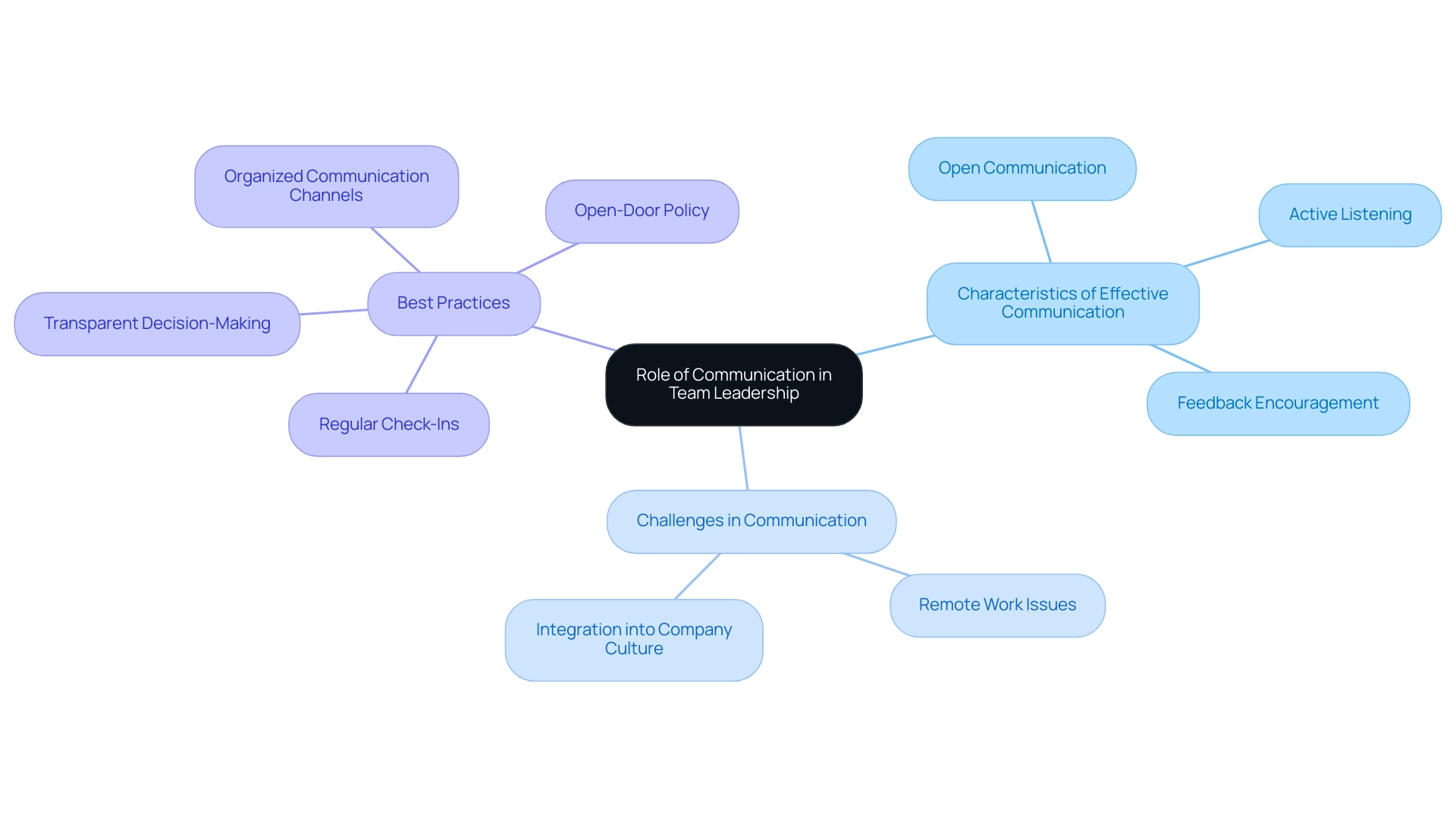
Core Responsibilities of a Team Leader
The primary responsibilities of a group supervisor encompass several essential team leadership characteristics, such as:
- Establishing clear goals
- Efficiently assigning tasks
- Providing support and direction
- Monitoring group performance
Competent individuals ensure that each group member understands their specific responsibilities and recognizes how their contributions align with the organization’s overarching objectives. This clarity is crucial, as research indicates that well-defined roles can significantly enhance group performance.
As we look toward 2025, the landscape of group leadership continues to evolve. Individuals in leadership roles are increasingly expected to embody team leadership characteristics by:
- Fostering a positive culture
- Resolving conflicts
- Promoting professional development
For example, leaders who engage in mentoring can greatly improve their team members’ skills and elevate overall morale. This approach not only cultivates a supportive environment but also exemplifies key team leadership traits that correlate with higher employee retention rates and improved group outcomes.
Notably, statistics reveal that 40% of H.R. Director positions are held by women, underscoring the importance of diversity in leadership roles. Efficient task distribution emerges as a critical factor for group success, with studies showing that teams with clear delegation strategies outperform those that do not.
Leaders who delegate tasks effectively empower their members, fostering greater autonomy and accountability. This empowerment is vital in today’s fast-paced work environment, where adaptability and responsiveness are essential for achieving long-term success. A case study on Boutique Recruiting illustrates this point; their meticulous approach to understanding company culture and specific job requirements enhances leadership effectiveness, enabling them to present candidates who seamlessly fit within organizational frameworks.
Boutique Recruiting specializes in identifying exceptional candidates for key positions such as Chief of Staff and Executive Assistant, ensuring that organizations have the right talent to cultivate effective leadership.
Furthermore, successful group supervisors exemplify team leadership characteristics by excelling at setting targets that are both achievable and aligned with the group’s capabilities and the organization’s strategic goals. By establishing clear, measurable objectives, leaders can guide their teams toward success while ensuring that each member feels valued and engaged in the process. Eric Eddy’s commentary on Boutique Recruiting’s ability to swiftly and effectively deliver high-quality candidates highlights the importance of strong leadership in achieving group success.
This strategic approach to leadership, with an emphasis on team leadership characteristics, is increasingly recognized as a hallmark of effective management in modern workplaces, especially as organizations must adapt to dynamic environments to ensure high employee retention and long-term success.
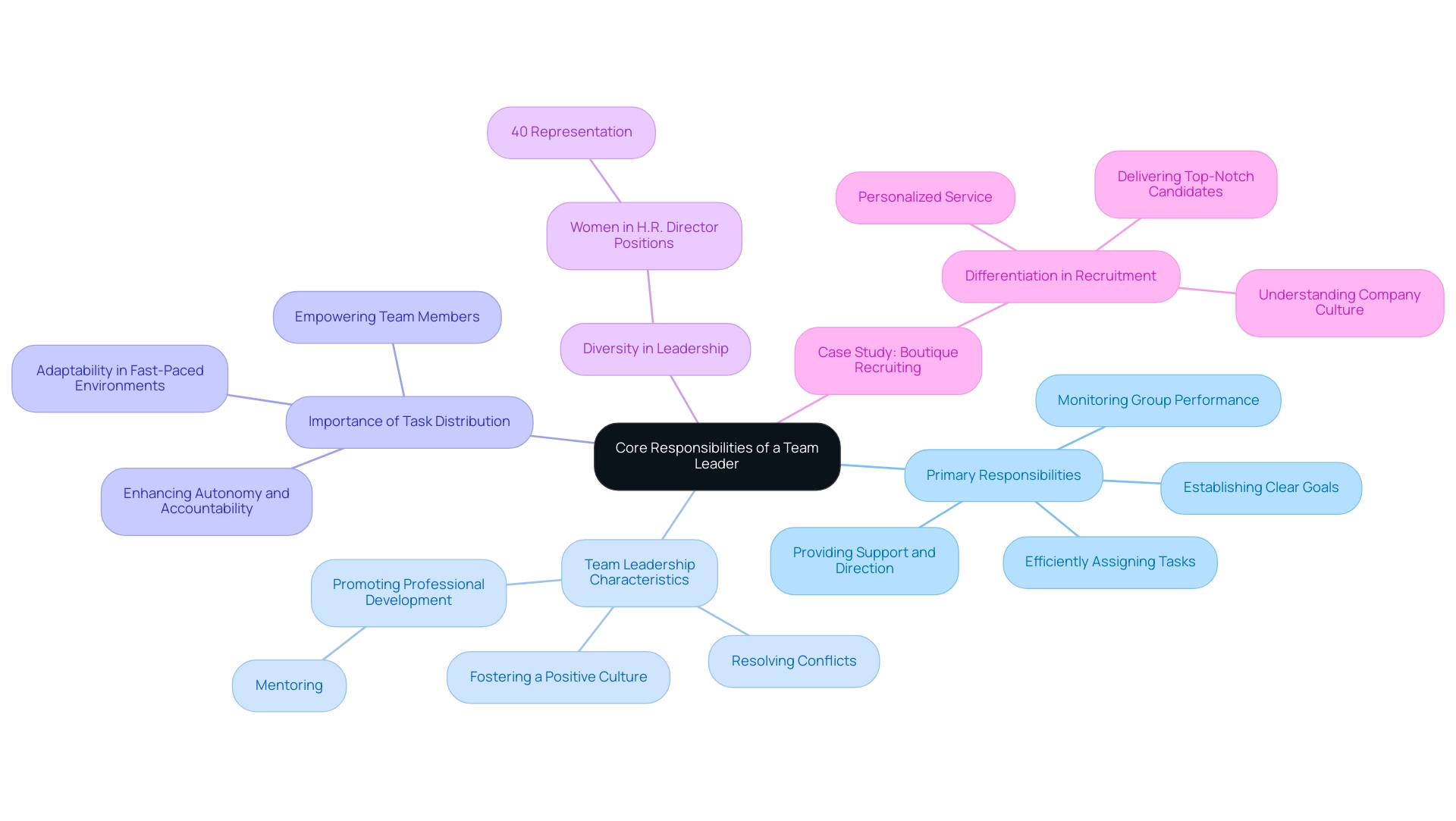
Challenges and Obstacles in Team Leadership
In 2025, group coordinators face significant challenges, particularly in managing diverse groups. With only 21% of organizations actively recruiting and promoting from diverse candidate pools, those in leadership roles often navigate a complex landscape characterized by varying communication styles, work ethics, and cultural backgrounds. This diversity can lead to conflicts, especially when team members hold differing perspectives on tasks or deadlines.
External pressures, such as tight deadlines and rapid organizational changes, further complicate these dynamics.
To effectively manage these challenges, leaders must embody essential team leadership characteristics and adopt a flexible approach. Strategies such as fostering an inclusive environment and employing conflict resolution techniques are crucial. As Eric Eddy notes, Boutique Recruiting has demonstrated the capability to deliver top-notch candidates swiftly and efficiently, underscoring their commitment to personalized service and tailored talent acquisition solutions across diverse industries in the U.S. and Canada.
This reality emphasizes the importance of effective leadership in recruitment. Additionally, a report by Hays reveals that 47% of employees depart from their positions due to poor company culture, highlighting the necessity for management to cultivate a positive workplace atmosphere that promotes engagement and collaboration.
Moreover, data indicates that 66% of employees believe they are more productive when working remotely. Leaders should contemplate implementing flexible work arrangements to enhance group performance, ensuring that remote work is bolstered by clear communication and collaboration tools. By maintaining open lines of communication and actively seeking feedback, leaders can ensure that all members feel valued and understood, which is vital for cohesion.
In summary, the team leadership characteristics, including the ability to adapt, communicate effectively, and implement conflict resolution strategies, are essential for leaders striving to navigate the complexities of guiding diverse groups in today’s fast-paced work environment. Furthermore, with just 5% of organizations indicating the capacity required to achieve their business objectives, the role of effective guidance becomes even more critical in addressing these challenges. Boutique Recruiting offers open positions throughout the U.S. and Canada, specializing in roles such as Chief of Staff, Project Manager, and various marketing and operational positions.
Partnering with Boutique Recruiting can provide the necessary support in sourcing high-quality talent to meet these demands. Visit our job board for an up-to-date list of openings.
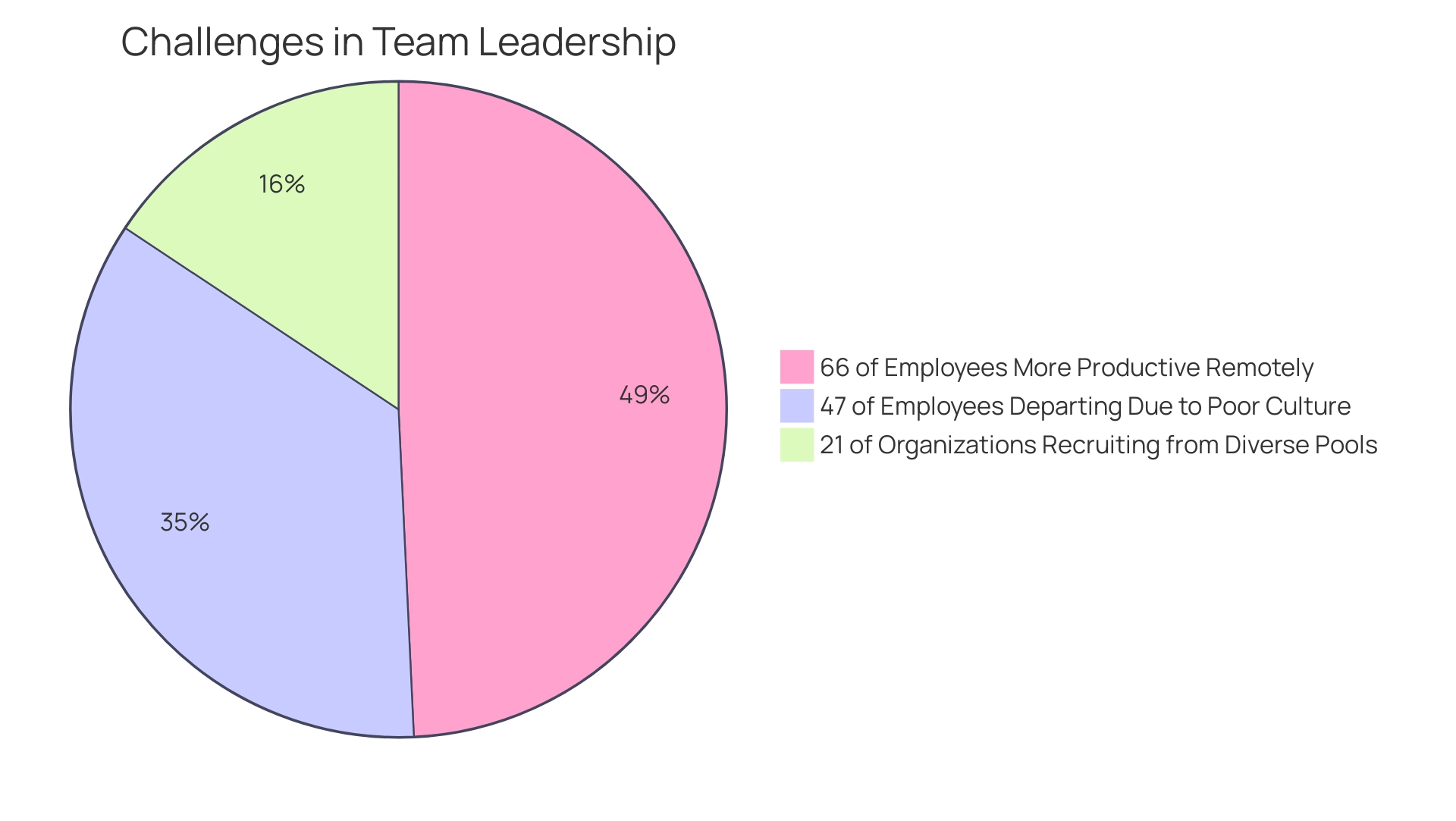
The Importance of Ethical Leadership in Teams
Team leadership characteristics are crucial for cultivating a positive group culture and driving long-term organizational success. Leaders who prioritize ethical behavior set a standard for their teams, promoting core values such as honesty, fairness, and respect. This commitment not only boosts group morale but also enhances the organization’s overall reputation.
Research indicates that approximately 85% of workers report that the nature of the task and pressure from management can lead to unethical behavior. This underscores the necessity for supervisors to model integrity and ethical decision-making to mitigate these pressures.
Consider the impact of managers who exemplify ethical practices; they can motivate their teams to uphold similar standards, fostering a culture of accountability and trust. This environment not only improves performance but also increases employee satisfaction. Furthermore, effective guidance, which reflects essential team leadership characteristics, is closely associated with a leader’s concern for organizational success and maintenance, as highlighted in qualitative studies analyzing various management styles.
These studies reveal that individuals who actively promote ethical behavior demonstrate vital team leadership characteristics that significantly influence group culture, leading to enhanced collaboration and productivity.
Expert insights emphasize that trust in individuals is twofold: reliance-based trust hinges on the individual’s work-related skills and knowledge, while disclosure-based trust involves the willingness of group members to share sensitive information. As noted by Prastio et al., fostering both types of trust is crucial for ethical individuals to create a supportive atmosphere that encourages open communication and ethical decision-making.
Moreover, the limitations of existing studies, such as small sample sizes and the need for future research, highlight the importance of ongoing exploration into the dynamics of trust and perception in guiding. The connection between task difficulty and supervisor attitudes indicates that ethical guidance can assist in alleviating negative perspectives in challenging scenarios, further emphasizing the necessity for leaders to exemplify ethical principles.
In conclusion, the influence of ethical conduct on group morale is significant; it molds the organizational culture and promotes collective success by exemplifying strong team leadership characteristics. Individuals who embody ethical principles not only motivate their groups but also contribute to creating a sustainable and flourishing work environment, as demonstrated by case studies on management styles and methods for effective guidance.
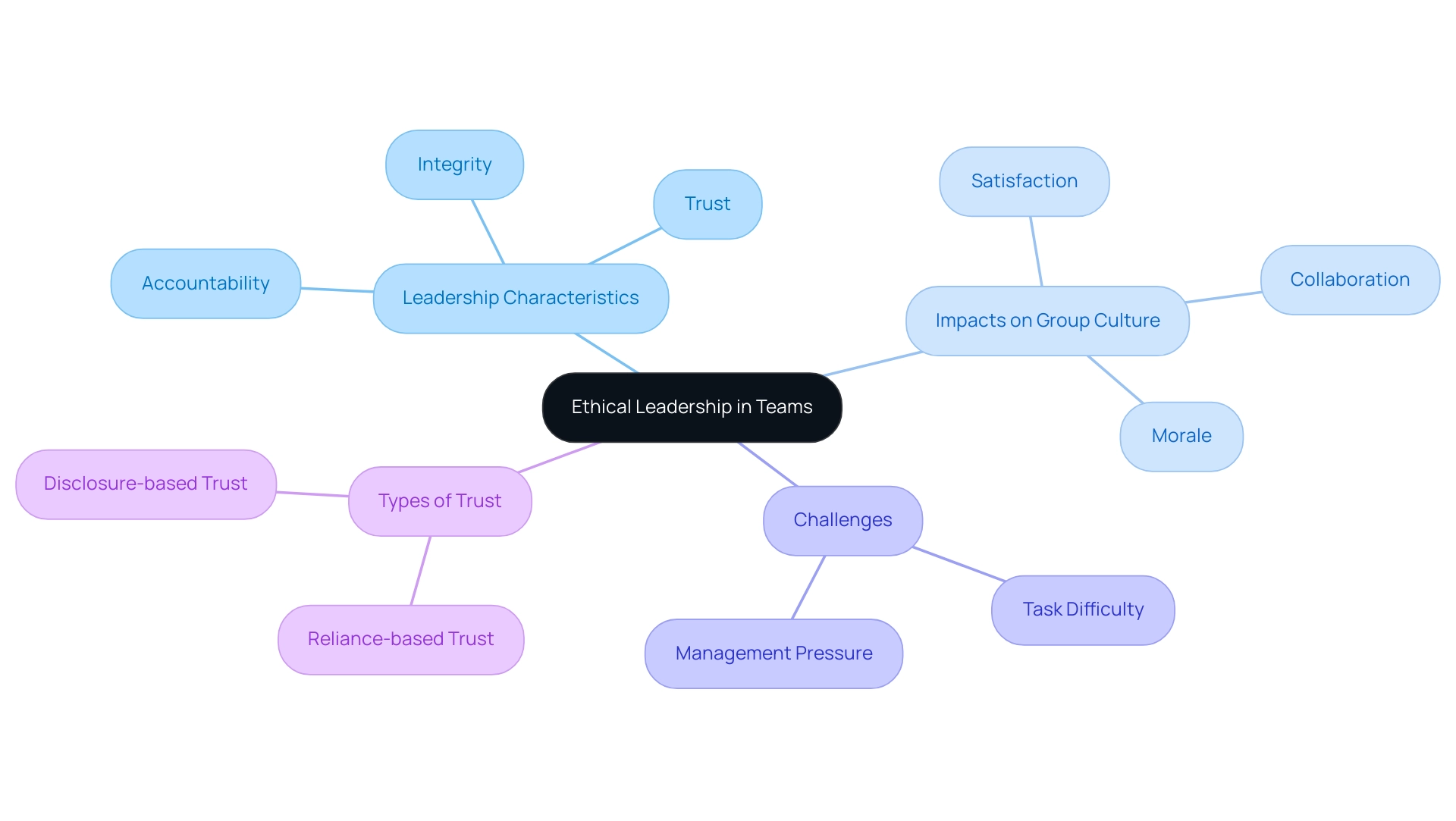
Exploring Different Leadership Styles and Their Impact
Various leadership styles, including transformational, transactional, and servant leadership, are pivotal in shaping group dynamics and enhancing overall performance. Transformational figures, for example, excel at inspiring and motivating their groups by articulating a compelling vision that resonates with the group’s values and aspirations. This approach not only boosts engagement but also fosters a sense of ownership among team members, resulting in increased productivity and innovation.
On the other hand, transactional figures emphasize structure, clear expectations, and rewards to drive performance. While this style effectively manages tasks and ensures accountability, it may not cultivate the same level of intrinsic motivation as transformational guidance. Indeed, studies show that organizations with high-performing management benches feature 22% more women in positions of authority and 36% greater background diversity compared to their lower-performing counterparts.
Remarkably, in 2023, nearly 90% of the global market included at least one woman in their upper management groups, underscoring the significance of diverse management styles in achieving optimal group performance.
Understanding these leadership styles enables individuals in authority to tailor their methods according to team leadership characteristics, addressing the unique needs of their groups and the specific environment in which they operate. For instance, leaders often express concerns about being favored by their group (80.7%), fulfilling assigned duties (30.4%), and whether their group meets performance standards (52.9%). By recognizing the strengths and weaknesses of each style, leaders can integrate team leadership characteristics to cultivate an environment that maximizes group effectiveness and engagement.
Case studies further illustrate the impact of management approaches on group dynamics. Organizations that prioritize employee recognition in their management practices have observed significant improvements in engagement and retention. This reinforces the notion that effective leadership transcends mere results; it also encompasses inspiring and motivating group members to realize their full potential.
As industry expert Joseph D’Souza aptly states, “While individuals in authority need to achieve results, their real value comes from their ability to inspire and motivate others,” thereby fostering a culture of collaboration and success.
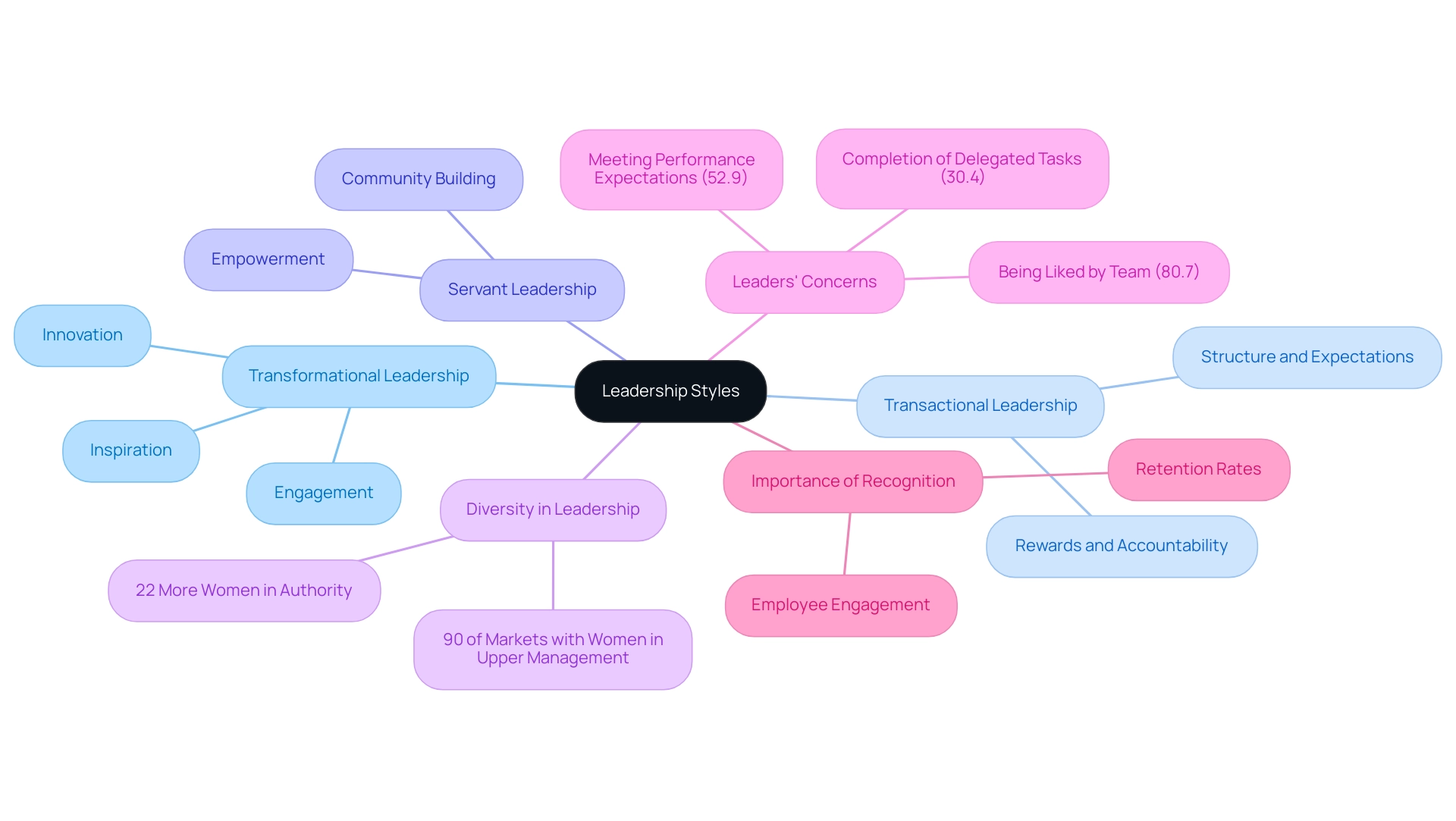
Fostering High-Performing Teams: Strategies for Leaders
To cultivate high-performing groups, leaders must adopt strategies that underscore essential team leadership characteristics such as collaboration, accountability, and a commitment to continuous improvement. Establishing clear goals is indispensable, providing both direction and purpose. Encouraging open communication allows group members to express their ideas and concerns freely, fostering an inclusive environment.
Acknowledging both individual and group accomplishments nurtures a sense of belonging and motivation, which is crucial for maintaining group morale. Significantly, studies reveal that 91% of workers admit to daydreaming during work meetings, underscoring the necessity of engaging participants during these interactions.
Team-building activities play a pivotal role in strengthening relationships and trust among team members. Regular feedback sessions, for instance, not only identify areas for improvement but also celebrate successes, reinforcing a culture of excellence. Engaging in activities that promote genuine communication—such as informal gatherings or collaborative projects—can markedly enhance group dynamics.
In fact, recent findings from Salesforce indicate that 75% of workers prefer to communicate with colleagues as they would with friends, highlighting the demand for a more authentic approach to workplace interactions. Runn emphasizes that collaborating online can enhance efficiency and support employee wellbeing, further validating the importance of effective communication strategies.
Moreover, the impact of team-building activities on performance cannot be overstated. Research indicates that groups participating in organized bonding exercises tend to outperform their counterparts, as these activities bolster cohesion and collaboration. Boutique Recruiting exemplifies this approach by focusing on establishing lasting relationships and understanding company culture, ensuring that the candidates they place are not only technically qualified but also a great match for the group dynamic.
Their meticulous approach to understanding job requirements, as highlighted in the case study titled ‘Differentiation in Recruitment Services,’ contributes to the creation of high-performing groups. By prioritizing these strategies, leaders can exemplify team leadership characteristics that foster an environment where teams not only thrive but also consistently achieve their objectives, ultimately contributing to the organization’s success.
Conclusion
In the dynamic landscape of modern workplaces, effective team leadership is essential for driving collaboration and achieving organizational success. This article has explored the multifaceted nature of leadership, highlighting the importance of key qualities such as strong communication skills, emotional intelligence, and adaptability. Leaders who prioritize these traits not only inspire their teams but also cultivate a culture of trust and accountability, which is vital for high performance.
Moreover, the significance of ethical leadership cannot be overstated. Leaders who model integrity and ethical behavior set a standard for their teams, fostering an environment that enhances morale and drives collective success. The challenges of managing diverse teams and navigating external pressures further underscore the need for leaders to adopt flexible and inclusive strategies.
As organizations evolve, understanding different leadership styles and their impacts on team dynamics becomes crucial. Transformational and servant leadership approaches have proven effective in motivating teams and fostering innovation, while transactional leadership can ensure accountability and structure. By tailoring their leadership style to meet the unique needs of their teams, leaders can maximize engagement and performance.
Ultimately, the path to cultivating high-performing teams lies in establishing clear goals, promoting open communication, and implementing team-building strategies. By investing in leadership development and prioritizing effective practices, organizations can enhance team dynamics and achieve long-term success. The role of team leaders, therefore, is not only to manage but to inspire and empower, creating an environment where every team member can thrive.
Frequently Asked Questions
What is group direction in the context of team leadership?
Group direction refers to the ability of individuals or collectives to guide and influence a team toward achieving shared objectives, integrating various skills, behaviors, and attributes indicative of effective team leadership.
Why are team leadership characteristics important in today’s work environments?
In fast-paced and dynamic work environments, team leadership characteristics that promote effective collaboration and adaptability are crucial for organizations to thrive.
What dual responsibilities do leaders have?
Leaders are responsible for managing tasks while also inspiring and engaging their teams, which is essential for fostering a culture of trust and accountability.
What percentage of C-suite executives find meaning and purpose in their roles?
Recent data indicates that 63% of C-suite executives find meaning and purpose in their roles, highlighting the importance of guidance in shaping organizational culture.
How do entry-level employees feel about their roles compared to C-suite executives?
Only 41% of individuals in entry-level positions report feeling meaning and purpose in their roles, suggesting a disconnect that effective leaders can help bridge.
What impact does management development have on organizations?
Organizations that prioritize management development often see significant improvements in staff engagement and retention, reinforcing the importance of investing in leadership development.
What are the statistics regarding leader burnout?
A case study on management burnout shows that 65% of leaders experience symptoms of burnout, which can hinder productivity and increase turnover rates.
What are the future trends in team leadership characteristics by 2025?
Future trends emphasize the necessity for emotional intelligence, adaptability, and strong communication skills, with leaders expected to be empathetic and responsive to their teams’ needs.
What are the essential traits of successful group facilitators?
Successful group facilitators exhibit effective communication, emotional intelligence, adaptability, decisiveness, integrity, and accountability, all of which drive group achievement.
How can employee engagement be positively impacted by leadership?
When leaders connect with employees to reinforce purpose, celebrate accomplishments, and cultivate relationships, employee engagement can increase significantly—by as much as 747%.
What is the gap in management development among companies?
Despite the recognized importance of management development, only 5% of companies have fully integrated it into their strategic initiatives, indicating a substantial gap between perceived value and prioritization.
How are AI-powered coaching tools expected to impact organizations?
AI-powered coaching tools are projected to save companies an estimated $20 billion by 2027, highlighting the growing recognition of effective guidance’s impact on organizational success.